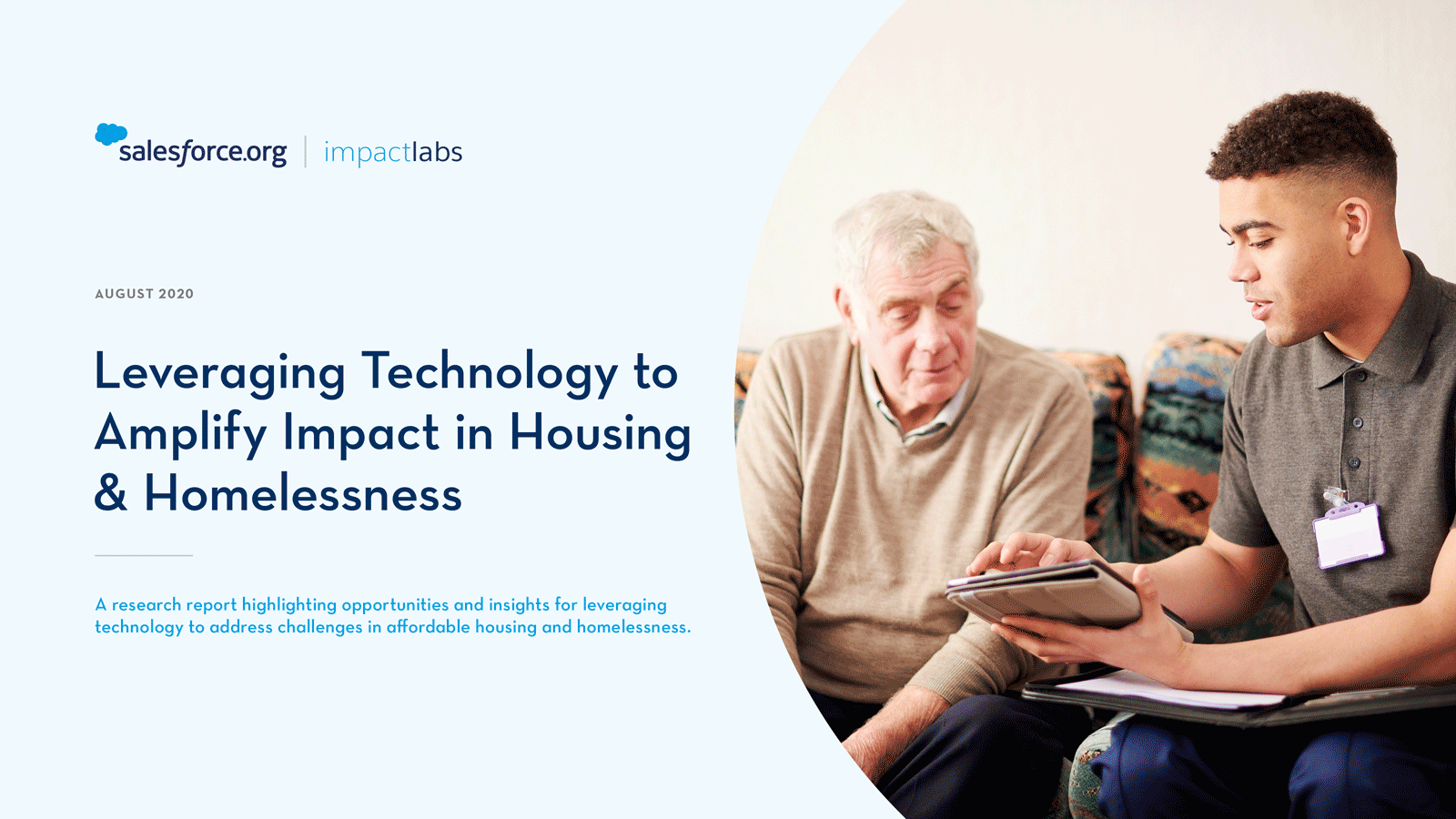When basics like shelter and food are uncertain, as is the case for the more than 500,000 Americans experiencing homelessness on any given night, technology is often an afterthought. While experts agree that more affordable housing and policy change are the most critical solutions to the homelessness crisis, technology advancements can support those goals by equipping governments and service providers in the sector with the right tools and data to help them serve their constituents.
In a research report released today, the Salesforce.org Impact Labs cohort, in collaboration with case managers, service providers, people who’ve experienced homelessness, and industry experts, identified three high-impact areas where technology can play an integral role in addressing this pervasive issue.
Read the Impact Labs report
A research report highlighting opportunities and insights for leveraging
technology to address challenges in affordable housing and homelessness.



We asked three of the Impact Labs Community Fellows to share their perspective and unpack these opportunities. Please welcome Kendra Froshman, Director of Impact and Learning for Compass Family Services, Barry Roeder, Data and Strategic Projects Manager for the San Francisco Mayor’s Office of Housing and Community Development, and Richard Saunders, and Product Director for Exponent Partners.
1. Create a connected experience
People experiencing homelessness often need to seek support and services across multiple agencies. It only makes sense, then, that their records should be easily shared across networks, counties, and providers. The current system, however, is an unconnected, discordant network that doesn’t work cohesively.
Amy Guterman: How can data integration and creating a connected experience support your organization, people experiencing homelessness, and the sector more broadly?
Kendra Froshman: Any time there is integration between different data systems, it means staff are able to spend more time with people experiencing homelessness and less time in front of a computer, which is a major win for everyone involved. It also has the benefit of better sharing information across the network of care providers and other stakeholders, ultimately reducing the number of times community members have to tell hard stories in order to access services and support.
Unifying the fragmented network of systems, programs, and software into one comprehensive platform won’t be easy, but the benefits of improved data and processes would be immense. We want to collect quality data about homelessness and we want to use that data to improve people’s lives, through advocacy for better policies and more affordable housing, and strong interventions that help people move out of poverty.
Richard Saunders: As a technology provider that assists nonprofits, Exponent Partners has a longstanding vision of a more connected, results-focused social sector. One of the keys to achieving this vision is integrated systems of care. The ability to measure a connected experience for the client allows nonprofits to measure performance and the impact of their programs. This enables nonprofits to move from counting the number of clients served to managing their outcomes as defined by their Theory of Change. With the right technology in place, an organization can start to measure the impact that they are having on the community they serve.

2. Improve findability of available housing and human services
Someone who’s never experienced homelessness or worked as a service provider may assume that finding available housing and services is as simple as conducting a Google search or tapping into a special database. However, because of a lack of trusted and unified resources, moving goalposts with eligibility requirements, and broad regions, finding services is an unreliable and surprisingly manual process.
The result is often wasted time and dead-end searches that lead to missed opportunities for housing or services.
Amy: From your experience, how can technology lead to improved access to and use of available housing and human services?
Barry Roeder: Leveraging technology, we’ve been able to streamline processes to find and apply for affordable housing. For example, with the San Francisco DAHLIA Housing Portal, we created a short-form common application to replace what was, in some cases, up to 15 pages long and unique for each property.
Kendra: Whenever technology can eliminate steps to find housing or other support services, it reduces barriers that separate resources from communities in need.
3. Capture and leverage data to inform success
One-way reporting is never a good thing in any business or organization. That’s infinitely more true when it comes to organizations that work to provide life-saving social safety nets for people living on the street.
Amy: How can technology better predict outcomes and help the sector evaluate what solutions best support communities and people experiencing homelessness?
Richard: Technology can provide a way to group and analyze data based on specific criteria. By providing these segmentation capabilities, a platform can help the sector recognize that a person is in a similar location, has similar needs, and is in a similar situation to a specific group of people.
If a nonprofit was trying to establish this correlation by examining paper files, this task would be arduous and time-consuming. With segmentation capabilities in place, a nonprofit can easily and quickly look at the data and identify what works best with this particular population or segment, examine best practices, and determine which service providers are best suited to meet the needs of people in this group, short- and long-term.
It is important to note that the system helps surface that information—it is not making the decisions for this individual or predicting what will happen. The technology does not replace a skilled case manager or social worker, rather it provides valuable insights into what is working or could work, and then allows a skilled case manager or social worker to best support communities and people experiencing homelessness.
Kendra: Technology can help us look at peoples personal experiences in aggregate to examine emerging trends, so that organizations are better able meet the needs on the ground. Based on data from our family assessment, Compass found that there are different types of employment needs among families. For example, families who are unemployed and lack formal job experience need different types of support than families who have several jobs but still can’t make ends meet. This helps frame our discussion about the employment resources we want to provide.
What’s next?
Aside from the three high-impact opportunity areas outlined above, the comprehensive report also details five principles for designing interventions to address the homelessness problem.
More affordable housing and progressive policy change in tandem with collaborative partnerships across the sector is absolutely imperative. And while technology is only one piece of a multi-faceted solution, we’re inspired by the possibilities and the model for collaborative partnership that the Impact Labs team represents. Their incredibly important work is a shining example of what’s possible when we work together.
Team Earth has landed
We believe that business is the greatest platform for change, and success should be for everyone on Earth and the planet itself. Because the new frontier? It’s right here.































